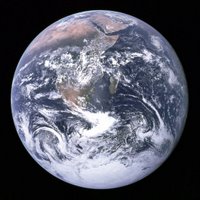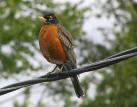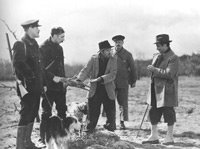The Blue Marble


It has been claimed that the image on the left, known as "The Blue Marble," is the most widely disseminated photograph in history, and I can understand why. Certainly, it has had a powerful hold on my own imagination since childhood, when I was utterly swept up by the high romance of the Apollo missions. But it hadn't quite been taken yet when I headed off to first grade in 1970, with an Apollo astronaut lunchbox to hold my bologna sandwich (Oscar Mayer of course), apple, and Tastycake. "The Blue Marble" picture was snapped in 1972, taken by the crew of Apollo 17 at a distance of about 28,000 miles from earth as they traveled toward the moon. The picture at right, "Earthrise," came first, with the Apollo 8 flight in 1968. I was four years old and nobody in the history of mankind had ever seen anything like it. To me it seemed like the most normal thing in the world--of course we can go to the moon! What I didn't know was that this view, this perspective, had given us the ability to see ourselves, our world, as we had never actually seen it before, as the tiny piece of the cosmos that it is. On the Apollo 8 mission the astronauts had been startled by the breathtaking "earthrise" phenomenon. They hadn't even been thinking about earth, since all their efforts were focused on getting out there (they were the first people ever to leave Earth orbit), when suddenly, there it was. I tried once (many years later, of course) to capture at least a piece of the moment in a poem (the flight occurred at Christmas):
apollo 8: earthrise
not a thought for
Earth (weightless, thoughtless)
leaving (the getaway)
technique, politics, routine
"a massive infusion
of technological strength"
Christ mass
in space, nostalgia for a
whole (planet)
Earthrise (looking back) floating
ornamental, fragile
"so very finite"
Earthrise, caught us all
by surprise
and there was a scramble
for the cameras
Almost despite ourselves we got, by virtue the massive technological enterprise of the Apollo missions, a profound moment of self-reflection. I think it changed us; I only wish it had changed us more.
***
Here's what Carl Sagan had to say under the inspiration of the later Pale Blue Dot image, taken from a far greater distance (more than four billion miles!) by Voyager I, in 1990:
"We succeeded in taking that picture [from deep space], and, if you look at it, you see a dot. That's here. That's home. That's us. On it, everyone you ever heard of, every human being who ever lived, lived out their lives. The aggregate of all our joys and sufferings, thousands of confident religions, ideologies and economic doctrines, every hunter and forager, every hero and coward, every creator and destroyer of civilizations, every king and peasant, every young couple in love, every hopeful child, every mother and father, every inventor and explorer, every teacher of morals, every corrupt politician, every superstar, every supreme leader, every saint and sinner in the history of our species, lived there on a mote of dust, suspended in a sunbeam.
The earth is a very small stage in a vast cosmic arena. Think of the rivers of blood spilled by all those generals and emperors so that in glory and in triumph they could become the momentary masters of a fraction of a dot. Think of the endless cruelties visited by the inhabitants of one corner of the dot on scarcely distinguishable inhabitants of some other corner of the dot. How frequent their misunderstandings, how eager they are to kill one another, how fervent their hatreds. Our posturings, our imagined self-importance, the delusion that we have some privileged position in the universe, are challenged by this point of pale light. Our planet is a lonely speck in the great enveloping cosmic dark. In our obscurity -- in all this vastness -- there is no hint that help will come from elsewhere to save us from ourselves. It is up to us. It's been said that astronomy is a humbling, and I might add, a character-building experience. To my mind, there is perhaps no better demonstration of the folly of human conceits than this distant image of our tiny world. To me, it underscores our responsibility to deal more kindly and compassionately with one another and to preserve and cherish that pale blue dot, the only home we've ever known."



